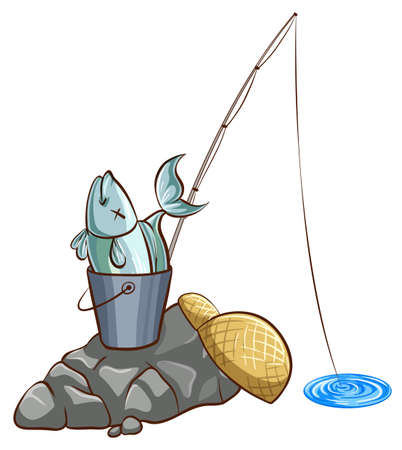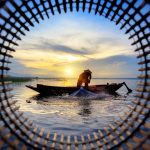1. Timing Is Everything
When the summer sun is blazing, knowing when to fish can make or break your day on the water. Fish, just like us, don’t love the heat. During the hottest parts of the day, they tend to move deeper or become less active. That’s why fishing during cooler times—like early mornings and late evenings—can seriously boost your chances of landing more bites.
Why Early and Late Are Best
In the early morning, water temperatures are at their lowest after cooling overnight. This makes fish more active and likely to feed near the surface or in shallower areas. In the evening, as the sun sets and temperatures drop again, fish often return to those same feeding spots.
Best Times to Fish During Summer
| Time of Day | Pros | Cons |
|---|---|---|
| Early Morning (5 AM – 9 AM) | Cool temps, active fish, low boat traffic | You have to wake up early! |
| Late Evening (6 PM – 9 PM) | Cooling water, great topwater action | Less daylight, bugs can be annoying |
| Midday (11 AM – 4 PM) | Good for deep-water species or shaded areas | Hot temps, sluggish fish, sun exposure |
Tips for Making the Most of Prime Hours
- Scout Your Spot: Visit your fishing location a day before if possible to find shady areas or shallow flats where fish may feed during cooler hours.
- Use Topwater Lures: In early morning and dusk, topwater lures like poppers or frogs can trigger explosive strikes from bass and other aggressive feeders.
- Stay Quiet: During calm morning waters, sound travels far. Keep noise minimal to avoid spooking fish.
If you’re serious about summer fishing success, setting that alarm clock a little earlier—or staying out a bit later—can mean the difference between going home empty-handed or reeling in that trophy catch.
2. Target Deeper, Cooler Waters
When the summer sun is blazing and the surface water feels like bathwater, most fish aren’t hanging out near the top anymore. Just like us, fish seek out cooler spots to stay comfortable and conserve energy. Understanding how fish behavior shifts in hot weather can seriously improve your chances of landing a catch.
Why Fish Go Deep in Summer
During the hottest months, surface temperatures rise and oxygen levels drop, especially during midday. This drives many species—like bass, walleye, and crappie—to move into deeper parts of lakes or rivers where the water is cooler and more stable. These areas offer better oxygen levels and protection from predators and harsh sunlight.
Where to Look: Key Summer Hotspots
If youre fishing in the heat, focus on these specific areas:
| Location | Why It Works |
|---|---|
| Deep Water Structures | Fish often hold near drop-offs, ledges, humps, or submerged points where they can move vertically with ease. |
| Shaded Areas | Docks, overhanging trees, and bridges provide relief from direct sunlight and can hold baitfish—and predators following them. |
| Thermoclines | This invisible layer separates warmer surface water from colder deep water. Many fish suspend just above or below this line for optimal comfort. |
How to Find Thermoclines
A fish finder or depth sounder is your best friend here. Look for a distinct line where the temperature changes rapidly—usually 10 to 20 feet down depending on the lake. Fish tend to hover around this zone during peak heat hours.
Pro Tip:
If you don’t have electronics onboard, start by fishing deeper during early afternoon when temperatures peak. If shallow areas go quiet, its a good sign that fish have moved deeper.
By adjusting your tactics and targeting cooler zones, you’ll not only stay ahead of the heat—you’ll also stay ahead of other anglers who haven’t adapted to summer conditions.
![]()
3. Match the Hatch with Summer Baits
During the hot summer months, fish behavior changes—and so should your bait selection. One of the most effective ways to increase your chances of landing a bite is to “match the hatch.” This means using lures and live baits that closely resemble what fish are naturally feeding on in your local waters during summer.
Understand What Fish Are Eating
In summer, many game fish focus on specific forage like shad, bluegill, crawfish, and insects. Knowing what’s abundant in your lake or river can help you choose the right bait. Pay attention to surface activity early in the morning or just before dusk—you might see schools of baitfish or bugs skimming the water, giving you clues about what to imitate.
Topwater Lures for Early Mornings
When the sun is low and the waters surface is calm, topwater action can be explosive. Bass and other predators often feed near the surface during these cooler parts of the day. Try using poppers, walking baits like a Zara Spook, or frogs over vegetation to draw strikes.
Recommended Topwater Baits
| Bait Type | Best Time to Use | Target Species |
|---|---|---|
| Popper | Early Morning / Late Evening | Largemouth Bass, Smallmouth Bass |
| Frog Lure | Dawn / Around Vegetation | Bass |
| Walking Bait (Zara Spook) | Low Light Conditions | Bass, Pike |
Soft Plastics for Midday Slumps
As temperatures rise and fish retreat to deeper or shaded areas, soft plastics become incredibly effective. These baits can be rigged in multiple ways—Texas rigged, Carolina rigged, or drop shot—to reach lethargic fish hiding in cover or suspended mid-water.
Popular Soft Plastic Choices for Summer
| Soft Plastic Type | Presentation Style | Ideal Conditions |
|---|---|---|
| Stick Worm (Senko-style) | Wacky Rig / Texas Rig | Clear Water / Heavy Cover |
| Craw Imitation | Texas Rig / Jig Trailer | Rocky Bottoms / Near Structure |
| Paddle Tail Swimbait | Slow Retrieve on Weighted Hook | Mimics Shad / Open Water Fishing |
Live Bait That Works All Day Long
If artificial lures aren’t doing the trick, switching to live bait can make a huge difference. In warm water conditions, fish often respond well to fresh and lively options. Minnows, nightcrawlers, and crickets are all solid choices depending on your target species.
Go-To Live Baits for Summer Fishing:
- Minnows: Great for crappie, bass, and walleye when fished near structure.
- Nightcrawlers: A classic for panfish and catfish; best fished near bottom.
- Crickets: Perfect for bluegill and sunfish when cast near docks or lily pads.
The key takeaway? Observe what the fish are feeding on and match it as closely as possible. Whether you’re working a frog across lily pads at sunrise or dragging a soft plastic worm through deep cover at high noon, choosing the right bait makes all the difference in hot weather fishing.
4. Gear Up for Heat
When the summer sun is beating down, having the right gear can make or break your fishing trip. Staying cool, protected, and hydrated isn’t just about comfort—it’s about safety too. Here’s how to prepare yourself and your tackle box for those blazing hot days on the water.
Stay Cool with Breathable Clothing
Wearing light, breathable clothing is essential when youre out in the heat. Look for moisture-wicking materials like polyester blends that pull sweat away from your skin and allow air to circulate. Long sleeves might seem counterintuitive, but lightweight long-sleeve shirts offer protection from the sun while keeping you surprisingly cool.
Recommended Summer Fishing Apparel
| Item | Why It Helps |
|---|---|
| Long-sleeve performance shirt | Provides UV protection and keeps you cool with moisture-wicking fabric |
| Lightweight fishing pants or shorts | Allows airflow while protecting legs from sunburn |
| Wide-brim hat or cap with neck flap | Keeps sun off your face and neck, reducing risk of heat exhaustion |
| Polarized sunglasses | Reduces glare on the water and protects eyes from UV rays |
Don’t Skimp on Sun Protection
Sunburn can creep up fast during long hours on the water. Use a broad-spectrum sunscreen with at least SPF 30, and don’t forget spots like ears, hands, and the back of your neck. Reapply every two hours or after heavy sweating or getting splashed.
Hydration Is Key
You’ll lose fluids quickly in high heat, especially if you’re active all day casting lines and reeling in catches. Bring a cooler packed with ice-cold water or electrolyte drinks. Avoid alcohol and too much caffeine—they dehydrate you faster.
Hydration Checklist for Summer Fishing Trips
- Pack at least one gallon of water per person for a full day trip
- Add electrolyte tablets or sports drinks to replenish minerals lost through sweat
- Use an insulated bottle to keep drinks cold longer
- Set reminders to drink every 30–45 minutes, even if you’re not thirsty yet
Heat-Resistant Fishing Gear That Can Take the Heat
Your gear needs to hold up under high temps too. Soft plastics can melt in direct sunlight—keep them shaded or in a cooler compartment. Choose reels with corrosion-resistant components since heat and humidity can wear them down faster. Braided line tends to hold up better than monofilament in hot conditions because it doesnt weaken as easily.
Tackle Tips for Hot Weather Conditions:
- Store lures and soft baits in shaded boxes or under seats to prevent melting
- Avoid leaving rods on hot surfaces where blanks can warp over time
- Lubricate reel parts regularly to prevent friction damage in extreme temperatures
- Cull older fishing lines more often—sunlight breaks them down faster than youd think
With the right gear and a little preparation, youll stay safe, cool, and focused on landing that next big catch—even when the mercurys rising.
5. Adjust Your Approach for Pressured Fish
Hot summer days don’t just bring the heat—they also bring crowds. With more anglers hitting the water, fish like bass get wise to common lures and presentations. If youre not getting bites, its time to switch things up with finesse tactics that work even on pressured fish.
Why Fish Get Finicky in Summer
During summer, increased fishing pressure means bass and other species have seen it all—Texas rigs, spinnerbaits, topwater frogs. They become cautious and less likely to strike aggressive or noisy presentations. That’s where finesse fishing comes in: smaller baits, lighter line, and a subtle approach can make all the difference.
Go Finesse or Go Home
When fish are acting shy, consider these proven finesse techniques:
| Technique | Best Bait | Ideal Conditions |
|---|---|---|
| Ned Rig | Small soft plastic on mushroom jighead | Clear water, high pressure areas |
| Drop Shot | Straight-tail worm or minnow bait | Deep structure or suspended fish |
| Wacky Rig | Senkos or stick baits hooked in the middle | Shallow cover or docks |
Make Small Tweaks for Big Results
You don’t always need to completely change your setup. Sometimes small adjustments can fool wary fish:
- Use fluorocarbon line for better invisibility in clear water.
- Switch to natural colors like green pumpkin or watermelon.
- Downsize your bait—go from a 5-inch worm to a 3-inch version.
- Add scent attractants to make your bait more enticing.
Tone Down Your Presentation
Aggressive retrieves can spook pressured fish. Try slow dragging, dead-sticking, or gentle twitches instead of fast jerks and cranks. Let your bait sit longer in the strike zone—you’ll be surprised how often a fish will bite after several seconds of stillness.
The Takeaway
If the lake is packed and the sun is high, think subtle. Lighten up your gear, scale down your lures, and focus on finesse tactics. These simple changes can turn a tough day into a successful one when everyone else is striking out.


